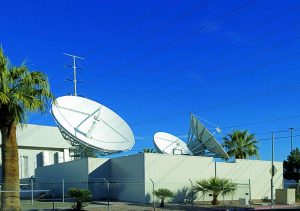 Teleports nowadays are having to deal with an increase in satellite communications on the go, and backhaul for clients. This creates growing demand for evolution of teleports, and the need to be future-ready.
Teleports nowadays are having to deal with an increase in satellite communications on the go, and backhaul for clients. This creates growing demand for evolution of teleports, and the need to be future-ready.
In essence, a teleport is a ground station providing access to satellites – possibly from a single antenna, but more probably with multiple antennas pointing to multiple satellites – to serve remote antennas in either a point-to-point or point-to-multi-point (broadcast) topology. Teleports also provide interconnection to the national infrastructure for internet, PSTN and leased lines for user services.
Roger Boddy, CEO of Global Teleports, says: “Since the inception of satellite communications into the international infrastructure, participating nations have provided international gateway teleports primarily for telephony service. Having said that, the initial broadcast by Telstar was analogue video.
“It is a fact that many international gateway teleports’ contribution to their hosts’ revenues was in excess of 50%, but the capital expenditure being amortised over 25 years meant their impact on the balance sheet was negligible – so it was overlooked when it came time to report to shareholders. C&W reports and accounts focused on the billions being paid for sub-sea cables and supporting vessel upkeep, with very little coverage of the ROI from their satellite ground station [teleport] investments – which at the time were accounting for 55% of group profits,” continues Boddy.
Manuela Leitner, GM of Horizon Teleports, adds that with video and media traffic, teleports are facing an increasing demand. Satellite television first hit the market in the early 1990s, and now DTH broadcasting is rapidly increasing in regions such as the Middle East. “The content and TV signal will be managed by teleports depending on the client’s requests and on the target region. In this way, teleports can distribute the broadcaster’s content directly via satellite to the home viewers in different formats from SD, DH or even 3D to the target region, to cable operators and IPTV platforms. Content from remote sources such as satellite news gathering (SNG) units can be transmitted via satellite to the studio or to the teleport.
“As bandwidth-hungry applications increase, teleports present a viable solution for higher bandwidth throughput and cost-effectiveness. The growing demand for bandwidth arises from services such as mobile applications, VoIP and GSM backhaul; to extend cellular coverage as an alternative or backup to terrestrial links; broadcasting – the contribution and distribution of programmes; and internet broadband services for networks and large satellite links.
“Teleports are capable of covering the growth in use of satcoms and backhaul, by using effective satellites with strong coverage and top-of-the-line equipment using the latest technology with best possible modulation – such as DVB-S2 or extended DVB-S2X, ACM option (Adaptive Coding and Modulation) – in order to maximise throughput regardless of link conditions, and carrier-in-carrier solutions,” explains Leitner.
So what happens in the event of downtime? Jean-Philippe Gillet, VP Sales MENA at Intelsat, says there are two types of downtime: planned and unplanned.
“Planned downtime is a coordinated effort between the operator and the customer, and due to the auto-redundancy of our network design, it has no real impact on customer operations. An example of a planned outage would be an equipment upgrade. When these operations are necessary, we coordinate with customers and use a restoration antenna to provide services while we complete the upgrades. Unplanned downtime occurs when there is equipment failure or degradation in the network. We have triple fibre redundancy at all of our commercial teleports, and our auto-switching redundancy keeps customer services online during any unplanned downtime. While customer operations continue via our redundant pathways, we fix the main path,” says Gillet.
Boddy takes this a step further and explains that if designed correctly, the infrastructure of a teleport will include equipment redundancy to minimise the options for single point failure, with equipment held in either hot or cold standby.
“Hot standby is the term applied to a component that is powered up and connected into the infrastructure ready to be switched into service, either manually or automatically (triggered by fault alarm). Cold standby is used to describe spare equipment that is kept on the shelf in readiness for use if required. Typically, a cold spare will be used to replace a faulty unit that has been hot switched out of use. The faulty unit is then replaced or repaired to become the cold standby unit. Service level agreements [SLAs] are an essential part of managing the customers’ expectations. An SLA will define realistic time scales for problem-solving and escalation of attention. All events are logged.”
Different teleports handle different satellite frequency bands. Most teleports handle spectra from C-band, Ku-band and Ka-band services. While Ka-band satellite services have gained traction and general customer acceptance, traditional Ku-band SATCOM is generally known as the preferred band for applications such as broadband internet, GSM backhaul, direct-to-home TV and satellite networks. However, Ka-band does not fit all applications and environments.
“When Ku-band systems first started in the 1980s, many experts speculated that C-band would disappear from use in VSAT applications. However, it has turned out to be the opposite, as C-band continues to grow and remain an important band in industrial, military and especially maritime applications, where atmospheric attenuation is particularly acute. C-band is well suited to robust connections in equatorial countries in order to avoid rain fade and overcome the impact of heavy rain.
“By comparison, the Ka-band is sensitive to rain fade, has only spot-beams and can only be used from some gateways of the satellite provider, which could cause unwanted dependency for clients. In general, all frequency bands have their place in satellite communications and choosing the right provider is essential, as they would be able to guide the customer in selecting the right band for their specific application,”
says Leitner.
Intelsat predominantly uses C-band and Ku-band. “We also have small packets of Ka-band services. In the government sector, there is also S-band and X-band. In general, all frequency bands have their place in satellite communications. It is the application environment that tends to determine the appropriate band, so teleports should be able to work with all bands to help provide the best value for the customer,” says Gillet.
He adds that the biggest changes he sees in the teleport industry is that the electronics involved in teleport operations have been getting smaller. Operations that previously required multiple racks of electronics can now be conducted using a fraction of a rack. This has resulted in less need for HVAC and less overall power at the teleports, so utility costs tend to go down.
“With the full integration of our teleports with our satellite fleet, we have the ability to efficiently cover the entirety of the globe, connecting multiple locations spread over vast distances. The combination of bandwidth, services and support enables network operators to design networks that provide reliable capacity to all end users, whether they are in metro areas, suburban areas or the most remote regions of their country. Many of our customers are doing business in multiple regions, and thus having a total solution with easy scalability reduces complexity and operating costs from their standpoint,” says Gillet.
Boddy thinks the move to higher frequency bands, and improvements in technology and silicon chip manufacturing, have enabled smaller antennas at gateway Earth stations. “32-metre diameter gateway leviathans in 1963 have been replaced by 3.8m antennas, with VSAT antennas from 3.8m to 75cm now commonplace. Cryogenic cooled masers, travelling wave tubes and klystron amplifiers have given way to solid state amplifiers operating at ambient temperature, with low voltage dc supply requirement, as opposed to the three-phase needs of the TWTs and klystrons. And the computers used no longer require a dedicated clean room and massive magnetic storage drums. Today’s modern teleport can occupy far less real estate than the original international gateway Earth stations, and may be privately held and entrepreneurially managed.”
Leitner thinks one major point is the change from DVB-S modulation to DVB-S2, saving up to 30% of bandwidth. Moreover, the latest DVB-S2X extension uses even less bandwidth. The MPEG 4 compression format uses less bandwidth than the previous MPEG 2. Even for multiplexing, Horizon Teleports is using statistical multiplexing with VBR (variable bit-rates) to save bandwidth there as well.
Infrastructural changes have also made newer teleports more efficient. Leitner says: “At Horizon Teleports, we have significantly improved the infrastructure compared to teleports in earlier days, by using state-of-the art equipment and implementing a comprehensive redundancy for all parts of the teleport. To connect antennas with the server room and the equipment, we earlier used co-axial cable, but now we use fibre cables, which reduce the delay time and failure rate.
“In former times the antennas were made of steel or iron, but nowadays we use galvanised antennas, which are more durable and weather-resistant. We also use new generation antenna control units, which more precisely track satellites.”
Securing the facility
Per Roger Boddy, security has to be considered both at the physical level and from an operations viewpoint. The latter usually comes down to choosing the right IT platform and diligently updating software. The former is a staffing issue which must not be taken lightly. Any point of entry to a national network has to be secure from the threat of physical intrusion, as well as from cyber-attacks.
According to Gillet: “In regard to the physical infrastructure, we have a basic security posture at all of our teleports. For the network operations, the satellite operator is responsible for ensuring the availability of the service, or making sure the path between the customer hardware and the teleport is always available. We break the general security model into how we are protecting the perimeter and how we manage access to the network.
“For the elements of the system that are responsible for transport that we own, we maintain security measures on those. As the satellite operator, our goal is to gather as much information as possible on what is happening with network traffic in real time. For example, we have tools integrated into our ground network that allow us to mitigate denial of service attacks very quickly,” explains Gillet.











Add Comment